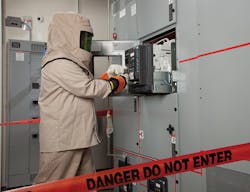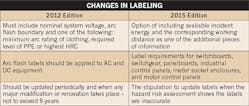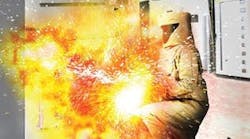It’s no secret that electricity is dangerous. According to the U.S. Bureau of Labor Statistics, between 2004 and 2013, nearly 2,000 fatal and more than 24,000 non-fatal electrical injuries occurred. The National Safety Council reports that electrical hazards cause nearly one workplace fatality every day. Beyond the risk of electric shock resulting from contact with energized equipment, today’s electrical workers face an increased risk of exposure to arc flash hazards, due in part to greater overall energy usage along with higher system voltages and available fault currents.
The Institute for Electrical and Electronics Engineers (IEEE) reports that 2,000 workers are admitted to burn centers each year for extended injury treatment caused by arc flash, which is defined by the National Fire Protection Association (NFPA) as an electric current that passes through air when insulation or isolation between electrified conductors is not sufficient to withstand the applied voltage. Arc flash produces temperatures up to 35,000°F, which is four times hotter than the surface of the sun. The resulting blast is similar to an explosion, creating enough force to throw a worker’s body across the room. Even someone standing more than 10 feet away from the fault source could be fatally burned by such a blast. Beyond the risk of personal injury and death, an arc flash event can also lead to:
• Business disruption
• Damage to equipment and facilities
• Legal liability
• Increased insurance premiums
• Hefty regulatory fines
To help reduce these risks and protect workers, NFPA develops and regularly updates its internationally adopted guidelines for creating a safe electrical work environment. The newest version (2015) of NFPA 70E, Standard for Electrical Safety in the Workplace, includes recommendations for identifying and assessing arc flash risks, communicating those risks, and training workers to protect themselves. This article outlines five steps you can take to comply with the latest NFPA 70E updates in your facility — and better protect your workers from the risk of exposure to arc flash.
Step 1: Assess the risk
In the 2015 version of NFPA 70E, which became effective in August 2014, the standard committee more clearly defined risk assessment as “an overall process that identifies hazards, estimates the potential severity of injury or damage to health, estimates the likelihood of occurrence of injury or damage to health, and determines if protective measures are required.” NFPA 70E requires facility owners to perform an arc flash risk assessment prior to allowing a worker to perform tasks on energized equipment (Table 1). Specifically, the assessment:
• Determines the presence and location of any arc flash hazards.
• Calculates incident energy.
• Determines arc flash boundary.
• Specifies appropriate safety-related work practices and the correct personal protective equipment (PPE) to be worn within the arc flash boundary.
This type of assessment is key to establishing an electrical safety program that reduces the risk of exposure to arc flash.
The latest version of NFPA 70E clearly dictates that as part of the arc flash risk assessment, the arc flash boundary distance must be determined for all locations where voltage is greater than 50V, and there’s a possibility of doing energized work such as maintenance, diagnostics, and testing. This requirement significantly expands the scope of arc flash protection and the number of locations that must be assessed.
While the arc flash PPE categories method (also called the “table method”) for determining arc flash boundaries is an alternative method outlined in NFPA 70E, the tables are often misused in the field, which can put workers at risk. How would a worker — even a qualified one — know the available fault current and protective device clearing time for various locations within the facility? This information is necessary to correctly apply the “table method,” and it can only be determined by calculation. To better protect workers, Sec. 130.5(C)(1) recommends performing an engineering analysis using one of the recognized means such as IEEE’s Guide for Performing Arc Flash Calculations (IEEE 1584).
To calculate incident energy, technical data should be reviewed and additional data collected (i.e., equipment type, voltage, ratings, and impedance.) To provide accurate results, use software to perform the arc flash calculations. Such software lets users evaluate alternatives quickly and easily to establish an optimal design for the overcurrent protective scheme.
The arc flash risk assessment is now the key to determining the necessity for workers to use PPE. If the arc flash boundary distance was calculated through engineering analysis, the results of the analysis are placed on the equipment label in the form of incident energy (in calories per square centimeter at working distance). Workers must determine if the Arc Thermal Performance Value (ATPV) of their protective garments meets or exceeds the incident energy value posted on the arc flash hazard label.
For those using the “table method” for determination of arc-rated PPE, NFPA 70E 2015 introduces a new multi-table format. First, look to Table 130.7(C)(15)(A)(a) to determine if arc flash PPE is required. This task-based table covers both AC and DC applications and indicates if an arc flash hazard is associated with each specific task — yes or no. If an arc flash hazard, exists, move to Table 130.7(C)(15)(A)(b) for AC situations, or Table 130.7(C)(15)(B) for DC situations, to choose the arc flash PPE category. Finally, refer to Table 130.7(C)(16), which lists the clothing and other PPE required for that category.
Step 2: Apply arc flash hazard labels
Both the National Electrical Code (NEC) and NFPA 70E require facility owners to apply an arc flash hazard warning label on electrical equipment. The 2015 Edition of NFPA 70E spells out the types of equipment that need to be labeled, including switchboards, switchgear, panelboards, industrial control panels, meter socket enclosures, and motor control panels.
The new standard also makes it clear what information needs to be included on field labels (Table 2):
• Nominal system voltage
• Arc flash boundary
• At least one of the following:
- Available incident energy and the corresponding working distance, or the arc flash PPE category as determined by the “table method,” but not both.
- Minimum arc rating of clothing
- Site-specific level of PPE
While arc flash labeling is now required for DC equipment in addition to AC equipment, today’s codes specify a number of exceptions to arc flash labeling requirements. Specifically, only electrical equipment that is likely to require examination, adjustment, servicing, or maintenance while energized needs to be field marked. Additionally, labels applied prior to Sept. 30, 2011, are still acceptable as long as those labels contain the available incident energy or required level of PPE.
Step 3: Train workers to identify and avoid risks
NFPA, along with the Occupational Safety and Health Administration (OSHA), recognizes the importance of determining a worker’s qualifications to work on or around electrical equipment. OSHA and industry professionals have indicated a clear preference for instructor-led courses as opposed to web-based training.
By developing a specific arc flash training program and complementary PPE plan that is based on the findings of the arc flash analysis, a facility can ensure workers fully understand shock and arc flash hazards and how to mitigate the risks. Implementing this best practice ultimately ensures compliance with NFPA 70E. In fact, the most current versions of the standard state that a qualified person shall:
• Be trained and knowledgeable in the construction and operation of equipment or specific work methods.
• Be trained to recognize and avoid the electrical hazards that may be present with respect to that equipment or work method.
• Be trained to assess the associated risk and perform the job safety planning.
• Demonstrate the ability to use — and not just be familiar with the proper use of — the following:
- A device to verify the absence of voltage (e.g., volt meter)
- PPE, including arc flash suits
- Insulating and shielding materials
- Insulated tools and test equipment
Additionally, qualified electrical workers permitted to work within the limited approach boundary of exposed energized electrical conductors and circuit parts operating at 50V or more must have training in minimum approach distances to exposed parts.
Step 4: Keep risk assessments, labels, and training programs up to date
NFPA 70E requires facilities to update arc flash assessments when a major modification or renovation takes place. It also requires that assessments be reviewed periodically — at least once every five years — to account for changes in the electrical distribution system (or changes in regulatory guidance).
The risk assessment must also take into consideration the maintenance of protective devices. NFPA 70E 2015 notes that improper or inadequate maintenance can result in increased opening time of the overcurrent device, thus increasing the incident energy.
Poor maintenance or major changes to the electrical distribution system clearly have the potential to impact the accuracy of arc flash labels, and thus the risk to electrical workers. However, replacing a fuse, replacing a circuit breaker or protective relay, and even changes made by supplying utilities can also affect arc flash analysis and the resulting field label information. Ideally, an arc flash assessment and label review should occur whenever any changes are made to the distribution system.
Workers must be kept up to speed on the latest safety practices. To ensure workers have adequate knowledge to protect themselves, NFPA 70E requires retraining at least every three years, whenever new procedures or practices are introduced, or when an audit indicates a need for additional training. Training dates and content for each employee must be documented.
Furthermore, facilities must conduct annual inspections to ensure each employee is complying with safety-related work practices. They must also audit their safety policy and training programs. This audit needs to be documented, and if deficiencies are identified, revisions must be made to bring all elements of the safety program into compliance.
Step 5: Don’t go it alone
Although the steps involved in identifying and mitigating potential arc flash hazards and complying with the latest changes to NFPA 70E can seem daunting, such compliance is the best way to protect your people and organization while avoiding citations and fines.
Many industry experts recommend working with well-trained, certified test engineers, and field technicians with a solid understanding of all new regulatory requirements. Such partners can help conduct the arc flash risk assessment and cost-effectively perform all required calculations. While there’s no legal requirement for a registered professional engineer to perform arc flash hazard analysis, such expertise helps ensure compliance with the standards and can save lives since improper calculations can put workers in grave danger.
The right service partner can also help your facility create, implement, audit, and maintain an arc flash labeling and hazard communication plan along with safety training based on the results of your arc flash assessment. Arc flash happens in an instant, but your people or operation can be impacted for years to come. The right electrical engineering or electrical testing service provider can help you navigate the latest regulatory changes, avoid the risks of non-compliance, and create a program that saves lives and dollars.
Vahlstrom brings more than 40 years of electrical engineering experience to his position as the director of technical services for Emerson Network Power’s Electrical Reliability Services group based in Westerville, Ohio. He can be reached at [email protected].






